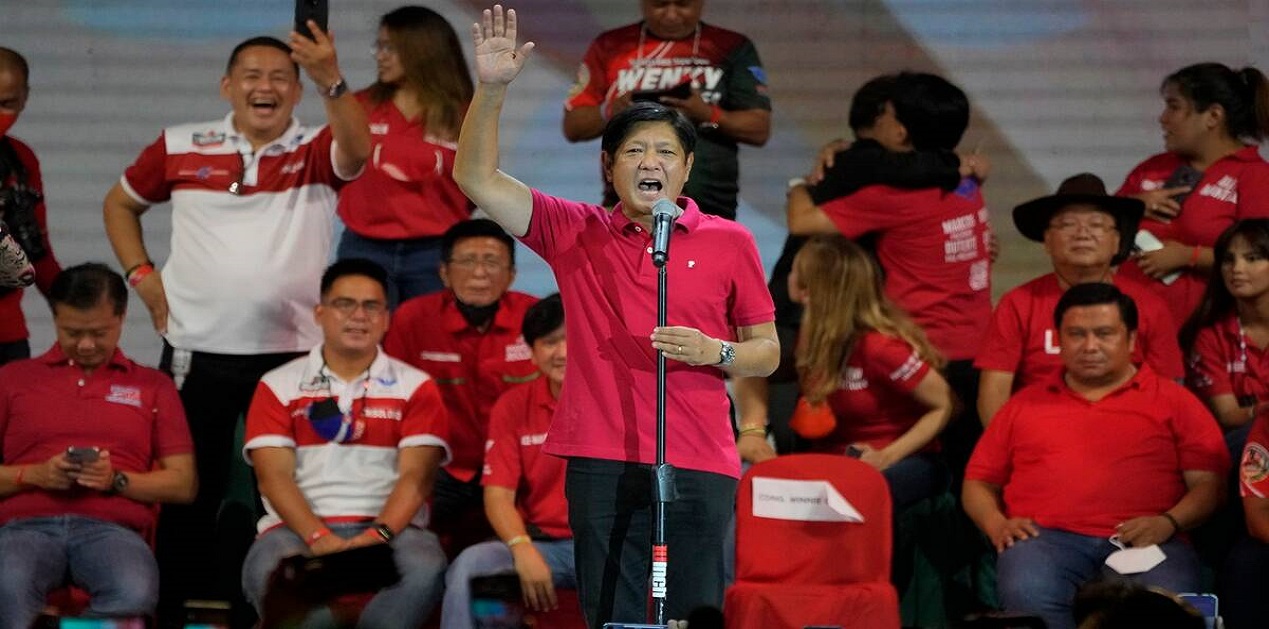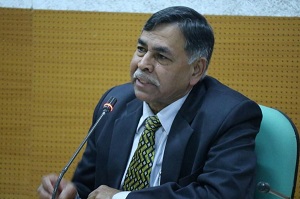Introduction
In the presidential election held on 9 March, the Filipinos elected a new leader, Ferdinand Marcos Jr. Popularly known as “Bongbong”, Marcos Jr. secured more than 56 per cent of the votes, which was more than double the tally of his nearest rival, liberal Maria Leonor “Leni” Robredo, a human rights lawyer and economist. The election outcome is an astonishing reversal in the fortunes of the Marcos family, who ruled with martial law for 20 years. Bongbong begins a six-year term as President of the Philippines at the end of June.
With the return of Marcos Jr. to the Presidential office, the Marcos family re-emerged from being a pariah to the high office within a space of few decades. Marcos Jr. appealed to the people not to judge him by the actions of his ancestors but by what he is going to deliver to the people. Duterte’s claims that his government found no evidence of ill-gotten wealth of the Marcos family contradicted the 2003 ruling of the Supreme Court that Marcos Sr. amassed ill-gotten wealth of more than $ 658 million went in Bongbong’s favour.
Amazingly, despite the fact that the senior Marcos couple, indulged in luxuries, left the country bankrupt, tortured and jailed tens of thousands of opponents during his time of dictatorship, the victory of their son to the high office proved that the memories of the people are short-lived. Interestingly, the outgoing President Rodrigo Duterte’s daughter Sara Duterte-Carpio also won the vice presidency in a landslide. This makes the rights groups, Catholic Church leaders and political analysts fear that the two offsprings of the past authoritarian leaders would now rule for the next six years with iron hands.[1] It defies the rationale why the people did not opt for a liberal to be their President.
Bongbong’s victory testified to an effective rebranding of his persona, abetted by Duterte’s decision to bury the senior Marcos in the National Heroes’ Cemetery, thereby affirming the imagined heroism of the dead despot. In November 2016, Duterte had dubbed Bongbong as a weak leader and a spoilt child but equation changed when his daughter Sara became Bongbong’s running mate. Bongbong and Sara’s victory was also because the opposition was weak and Duterte denigrated Robredo as incompetent and unfit to be president. [2] As regards the allocation of portfolios, though Sara preferred to be the Defence Secretary, she was offered the education portfolio.
Filipinos have high expectations from Bongbong, seeing him as their saviour and believe that he can deliver best and avoid the worst mistakes committed by his father.[3] With their performance, both Bongbong and Sara are expected to shake off the baggage of their family names. The younger generation voters were willing to forget the issue that hounded the Marcos family – corruption, human rights violations, killings and plundering billions of dollars from state coffers, and Duterte’s harsh measures on drug mafias, and thus reposed their faith on these two families’ descendents by voting them to office. Though disillusioned by unfulfilled promises from the Duterte administration to lower costs of living, end labour contract and clean up the system, the voters reposed their faith that Bongbong can deliver. Voters felt that Bongbong is their saviour, believing he can usher in the rapid economic growth that characterised the early era of his father’s rule. They expect that the new administration would lower prices of commodities, create more jobs, continue the war on drugs and find solutions to the deeply rooted corruption in the country.
At the same time, there are fears that Bongbong could be worse than Duterte as people cannot forget that thousands died from Duterte’s war on drugs, thousands of activists killed or went missing under Marcos Sr’s martial law. Some even see the old Marcos era returning, putting the nation at risk. In 1986, his family fled into exile in Hawaii after the People Power Revolution ended Marcos’ 20-year rule (1965 to 1986). His wife Imelda and the children were allowed to fly back home three years after his death in exile in 1989. Since then, it has been a slow political rehabilitation and re-entry to politics by the Marcos family, culminating in the victory of Bongbong to occupy the palace that was once his father’s abode for 20 long years. First, Bongbong became the governor of Ilocos Norte province and was congressman from 2007 to 2010 and Senator from 2010 to 2016. His sister Imee, was a Senator and the mother Imelda was elected as Congresswoman. This means that the Marcos name was no longer solely associated with the misdeeds of the father.
This is the domestic positioning of Bongbong and his domestic political space. What about his foreign policy outlook? Compared to his predecessor’s softer approach towards China, Bongbong’s stance on foreign policy, particularly on China that contrasts with Duterte’s softer approach, could help unite Filipinos behind nationalist issues, such as reinforcing the 2016 international court ruling in favour of the Philippines over disputed waters in the South China Sea, against Beijing’s claims. He also needs to correct Philippines’ image that tarnished the country’s image because of Duterte’s extrajudicial killings on wars on drugs. It remains to be seen if Bongbong would continue the anti-drugs crackdown policy of his predecessor Duterte government.
Before foreign policy takes centre stage, there are domestic challenges. The priority of the 64-year-old Marcos Jr. would be to address the critical areas such as tackling the economic crisis caused by the Covid-19 pandemic that the country’s 31 million people face. Issues such as crisis in energy, lack of jobs, education and infrastructure need priority attention.[4]
In foreign policy front, Bongbong needs to prioritise protecting Philippines’ sovereignty against Chinese pressure, and human rights of all Filipinos. The world would be more interested to know what policy Marcos Jr. adopts on South China Sea, especially how it responds to ongoing Chinese maritime expansion which relies on naval force.[5] The fear is if Russia ignored restraints by the international community and launched a special military operation against Ukraine, this might embolden China to resort to similar unilateral claims to sovereignty in South China Sea. Duterte’s policy of appeasing China to get economic benefits needs to be reversed. Though the Philippine got a ruling in its favour from the Permanent Court of Arbitration in The Hague, which gave out its judicial ruling based on the UNCLOS that China’s sovereignty claims to the South China Sea lack any legal basis, and the Duterte administration did not pursue the issue further; Bongbong ought to look into this issue afresh as China’s expansionist designs have to be contained.
The rulings could be discussed in the forthcoming Quad summit being hosted by Japan on 24 May 2022. Philippines have already developed understanding with some of the Quad members on defence cooperation. For example, in April 2022 Japan and the Philippines held their first foreign and defence ministerial security (2+2) talks and discussed to deepen defence cooperation. Also, the militaries of the US and the Philippines held their largest joint exercises recently. Under Bongbong, more such activities are expected backed by mutual understanding to promote freedom and democracy. This being so, while the young generation cannot understand the brutality during the long period of Marcos Sr.’s dictatorship and repose faith on the junior Marcos, the elder generation witness to the senior Marcos’s brutal rule fear that dictatorship could return to the Philippines. The immediate concern of many however is whether Bongbong would be cozy up to a belligerent China as his predecessor Duterte did. Bongbong’s leadership style shall be closely watched by the international community.
This brings us to the question of understanding what Japan-the Philippines defence cooperation mean in the larger context of securing peace in South China Sea and the region. The crucial consideration for Japan to get close with the Philippines is because the sea around the Philippines is a major sea lane for Japan and wants that the Philippines do not come under China’s orbit as was the case during Duterte’s tenure. This single most consideration makes a strong case for Japan-Philippines cooperation on defence. The 2+2 meeting in April was important from this perspective. [6] The underlying factor driving this kind of cooperation between Japan and the Philippines is that both are maritime nations, which share fundamental values such as the rule of law, freedom and democracy and addressing to the China challenge that ignores such values with autocratic outlook. The joint statement of the Japan-Philippines 2+2 dialogue expressing to strengthen overall defence relationship through the consolidation of defence capabilities, navy port calls and the transfer of defence equipment need to be understood. [7] The next stage of Japan-Philippines could be on Reciprocal Access Agreement (RAA) and other agreements that would serve as a legal basis to grant Japan’s Self-Defense Forces and the Philippine armed forces reciprocal access, with eyes set on conducting joint exercises. The US is also on the same page.
The biggest issue of concern is that China has been constructing artificial islands and turning them into military bases in disregard of international law, violating the rights of the Philippines, Vietnam, and other countries that have territorial claims and rights to islands in the South China Sea. China’s ostensible “fishing vessels” roaming the Philippines’ exclusive economic zone with maritime militias on board is a matter of concern.
Where does India Figure in this Matrix?
As regards the South China Sea, India shares the same concern of the claimant countries to their EEZs and opposed China’s unilateral actions in this oceanic space critical to many maritime nations. India has even joined in commercial activities such as oil drilling in Vietnam’s EEZ. India went there on Vietnam’s invitation for joint collaboration. If India’s national interests are affected by Chinese incursions that affect the project, India would be within its rights to defend, if necessary militarily, its interests. It also needs to be noted that India has signed an agreement with the Philippines for the supply of Bramos missiles to buttress the deterrent capabilities of their armed forces. If Bongbong pursues a similar policy like that of Vietnam, Philippines can be assured of India’s support. Given the strong ties between India and Japan, and Japan’s economic interests in Southeast Asia, greater cooperation between India, Japan and the Philippines could be explored. A similar India-Japan-Vietnam trilateral framework is already being talked about in academic circles. If India, Japan and the Philippines show interests, a similar concept can too be explored. Bilateral and regional issues can be discussed and a common ground can be found for the benefits of all stakeholders.
Endnotes :
[1]Ferdinand Marcos Jr claims victory in Philippine election”, 11 May 2022, https://www.channelnewsasia.com/asia/crisis-hit-sri-lanka-set-uneasy-economic-war-cabinet-2687616
[2]Ronald D. Holmes, “Philippines: Despite Huge Victory, Bongbong Overwhelms”, East Asia Forum, 16 May 2022, https://www.eastasiaforum.org/2022/05/15/despite-huge-victory-bongbong-underwhelms/
[3]Jeff Bansigan, “Maros Jr’s popularity shows lasting appeal of strongman leaders in the Philippines”, 12 May 2022, https://www.channelnewsasia.com/commentary/philippine-president-election-bongbong-marcos-jr-duterte-father-2678086
[4]Pichayada Promchetchoo, “Bongbong Marcos reveals plans for Philippines after landslide election win”, 11 May 2022, https://www.channelnewsasia.com/asia/bongbong-marcos-plans-philippines-election-win-2678521
[5] “Will Marcos Cozy Up to China and Risk Alienating Democratic Countries?”, The Sankei Shimbun, editorial, 17 May 2022, https://japan-forward.com/editorial-will-marcos-cozy-up-to-china-and-risk-alienating-democratic-countries/
[6] “Deterring China Should Be a Common Defense Goal of Japan and the Philippines”, Japan Forward, editorial, 19 April 2022, https://japan-forward.com/editorial-deterring-china-should-be-a-common-defense-goal-of-japan-and-the-philippines/
[7] https://www.mofa.go.jp/files/100329868.pdf
(The paper is the author’s individual scholastic articulation. The author certifies that the article/paper is original in content, unpublished and it has not been submitted for publication/web upload elsewhere, and that the facts and figures quoted are duly referenced, as needed, and are believed to be correct). (The paper does not necessarily represent the organisational stance... More >>
Image Source: https://images.indianexpress.com/2022/05/Phillipines-Polls.jpg











Post new comment